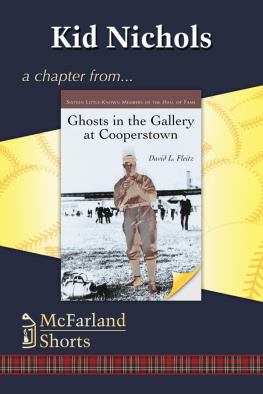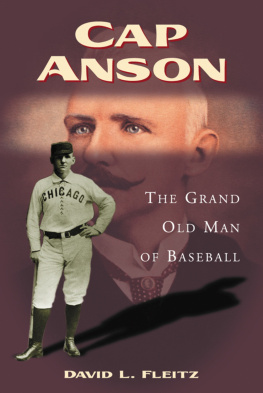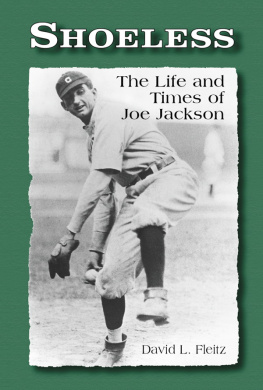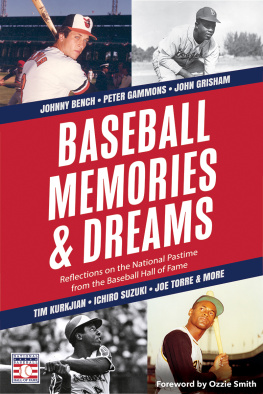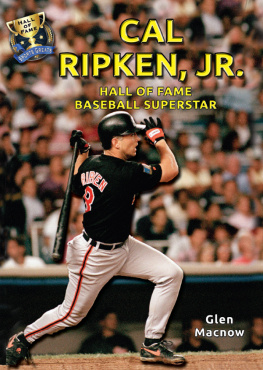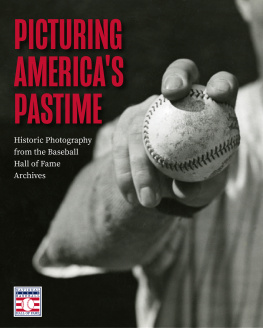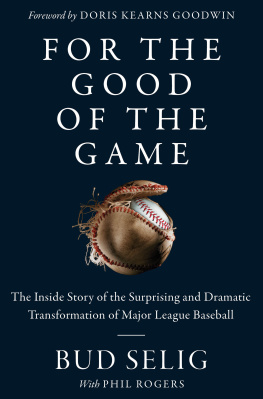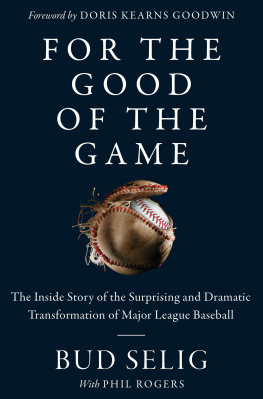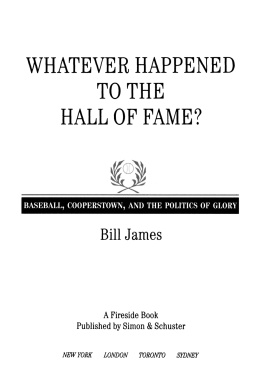
Contents
Also by David L. Fleitz
Silver Bats and Automobiles: The Hotly Competitive, Sometimes
Ignoble Pursuit of the Major League Batting (2011)
The Irish in Baseball: An Early History (2009)
Shoeless: The Life and Times of Joe Jackson (2008, large print edition; paperback 2001)
More Ghosts in the Gallery: Another Sixteen Little-Known Greats at Cooperstown (2007)
Cap Anson: The Grand Old Man of Baseball (2005)
Louis Sockalexis: The First Cleveland Indian (2002)
Kid Nichols is a chapter from the book Ghosts in the Gallery at Cooperstown: Sixteen Little-Known Members of the Hall of Fame, by David L. Fleitz.
LIBRARY OF CONGRESS CATALOGUING-IN-PUBLICATION DATA
Fleitz, David L., 1955
Ghosts in the gallery at Cooperstown : sixteen little-known members of the Hall of Fame / by David L. Fleitz.
p. cm.
Includes bibliographical references and index.
ISBN 978-1-4766-0252-3
1. Baseball playersUnited StatesBiography. 2. Baseball playersUnited StatesStatistics. 3. National Baseball Hall of Fame and Museum. I. Title.
GV865.A1F54 2004
796.357'092'2dc22 2003026012
British Library cataloguing data are available
2004 David L. Fleitz. All rights reserved
No part of this book may be reproduced or transmitted in any form or by any means, electronic or mechanical, including photocopying or recording, or by any information storage and retrieval system, without permission in writing from the publisher.
Cover photograph: Kid Nichols (National Baseball Hall of Fame Library, Cooperstown, N.Y.)
McFarland & Company, Inc., Publishers
Box 611, Jefferson, North Carolina 28640
www.mcfarlandpub.com
Kid Nichols
I take pride in two things. My election to baseballs Hall of Fame and the fact I never was removed from a game for a relief hurler.Charles (Kid) Nichols
When the Hall of Fame was created in the mid1930s, the institution wrestled with the issue of electing early players, executives, and other deserving contributors. A separate election for 19th century stars was held in 1936, but the voting process was not well planned, and no one gained the required number of votes for selection. In response, Commissioner Kenesaw M. Landis created a committee to select 19th-century players and pioneers for induction. This committee went through several changes and emerged in 1944 as the Permanent Committee, charged with electing men whose careers ended before 1910.
Perhaps it was inevitable that some deserving candidates would fall through the cracks and escape the committees attention. One such player was Charles Kid Nichols, who pitched in the National League from 1890 to 1906 and won 360 games, the fourth-highest total in league history. He also led the Boston Beaneaters to five pennants in the Gay Nineties. Nichols, who in the early 1940s was alive and well and managing a bowling alley in Kansas City, had been retired from baseball for nearly four decades. Since no major league team at the time played further west than St. Louis, Nichols had remained outside of baseballs orbit for all those years. I went back out West when I quit baseball, said the Kid. People just forgot about me. I guess they thought I was beyond the frontier or something.
In the four earliest Hall of Fame elections conducted by the BBWAA in the 1930s, Nichols had never gained more than seven votes from more than 200 participating voters. In 1945, the Permanent Committee, later known as the Veterans Committee, selected ten old-time players to the Hall. The committee members chose three of Kids Boston teammates (Jimmy Collins, Mike King Kelly and Hugh Duffy), but bypassed Nichols. Many writers and fans, those who remembered the long-retired Kid, thought it strange that a pitcher who won 30 or more games in a season a record seven times had not yet been honored with a plaque in the Cooperstown museum.
Ty Cobb, Cy Young, Clark Griffith, and other old-time stars lobbied both publicly and privately for Nichols election, but in 1946 the Permanent Committee threw another curveball. The committee selected pitchers Rube Waddell (193 wins), Jack Chesbro (198 wins) and Ed Walsh (195 wins) and bypassed the 360-game winner, Nichols, once again. Id like to be in there [in Cooperstown], said Nichols in 1941, but they forget about us old codgers in a hurry.
The committee, stung by the public criticism of its 1946 selections, went into hibernation for three years, but on May 7, 1949, the Permanent Committee met again and named the 79-year-old Kid Nichols to the Hall of Fame. I was never so pleased in my life as when I was selected, said the old pitcher. Its a fine thing for my four great-grandchildren. He attended the induction ceremony that summer, traveling by car from Kansas City to Cooperstown with a side trip to Buffalo, where he attended the annual convention of SPEBSQSA, the national association of barbershop-quartet enthusiasts. At the Cooperstown ceremony, held on June 13, 1949, principal speaker Branch Rickey praised Nichols as one of the great pitchers of the olden days.
Charles Augustus Nichols, the son of a butcher and a housewife, was born on September 14, 1869, in Madison, Wisconsin. He was the seventh child of Robert and Christina Nichols, who began their married life in New York state and moved to Madison about ten years before Charles was born. Not much is known about the future ballplayers early life, except that the family moved West once again, this time to Kansas City, Missouri, when Charles was 11 years old.
His older brothers worked for their father in the family butcher shop, but from an early age Charles Nichols set his sights on a baseball career. Charles, though not a big or muscular boy, was nonetheless a fine athlete. He played ball on vacant lots in his new hometown, and soon graduated to pitching for local amateur teams. Charles weighed no more than 135 pounds as a young teenager, but he displayed a surprisingly good fastball and fine control.
In 1886, when Charles was 16, he secured a tryout with the major league Kansas City Cowboys of the American Association. He didnt make the team, but in 1887, after the Cowboys dropped out of the Association and entered the lower-level Western League, Charles Nichols tried out again. Once more the Cowboys turned him down, but by June the injury-riddled club was short on pitchers. They signed Charles to a contract on June 10 of that year. The older players on the club were surprised by the presence of this baby-faced teenager; they first addressed him as Batboy, then as Kid, a name that stuck and became the young mans nickname for the rest of his life.
The newly-christened Kid pitched well for a 17-year-old, posting an 1813 record while batting .298 in 33 games for the Cowboys. Nichols was not yet a finished pitcherhe struck out only 65 men in 285 innings and allowed 386 hitsand the Cowboys released him after the season. In 1888 Kid joined Memphis of the Southern League and went 109 before the league collapsed in mid-season. Kansas City re-signed him in July of 1888, and Nichols rewarded the Cowboys with 16 wins in 18 games and a microscopic 1.14 earned run average.
Kid Nichols, now 18 years old, began to mature as a pitcher. As he grew bigger and stronger with age, his fastball improved until it was one of the best in the Western League. Kid threw four shutouts among his 16 wins and, for the first time, allowed less than one hit per inning.
The Cowboys re-entered the American Association for the 1889 season and decided not to take their teenaged pitcher with them, so Kid Nichols signed with Kansas Citys Western League rival, Omaha. Managed by future Hall of Fame member Frank Selee, Omaha won the pennant as Nichols turned in one of the most remarkable pitching performances of the 19th century. He compiled a wonlost record of 398, striking out 368 men in 438 innings. In September 1889, William Conant, one of the three principal owners of the National Leagues Boston Beaneaters, paid the Omaha club $3,000 for Nichols release and signed the 20-year-old pitcher to a contract for 1890.
Next page
